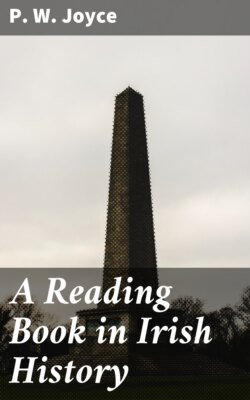Читать книгу A Reading Book in Irish History - P. W. Joyce - Страница 6
На сайте Литреса книга снята с продажи.
IV.
CUSTOMS AND MODES OF LIFE.
ОглавлениеTable of Contents
Our old books contain very full information regarding the Irish people, and how they lived, more than a thousand years ago.
In early times Ireland was almost everywhere covered with forests; and there were great and dangerous bogs and marshes, overgrown with reeds, moss, and coarse grass. Many of these bogs still remain, but they are not nearly so large or dangerous as they were then. Great tracts of country were uninhabited, so that the whole population was much less than it is now.
Ancient Irish bronze reaping-hook: 6 inches long. It was fitted with a handle which was fastened in the socket with a rivet. Now in the National Museum, Dublin.
The people hunted and fished a great deal, partly for food, partly to rid the country of noxious creatures, and partly for sport; for the forests were alive with wild animals of all kinds, and the rivers and lakes teemed with fish. But no one then thought it worth while to hunt foxes and hares for sport, as people do now. They had much grander game:—wild boars with long and dangerous tusks; gigantic deer; and fierce wolves that lurked in caves and thick woods. In the cleared parts of the country there was much pasture and tillage various kinds of corn and vegetables were grown, and the land was very fertile and well watered with springs and rivulets.
A moat: at Patrickstown, near Oldcastle, Co. Meath. Some moats were burial mounds. See pages 16 and 59.
There was more pasture than tillage; and the pasture land was not fenced in, but was grazed in common. The law was very particular in laying down rules about the fences of tillage lands—that they should be properly made, and that when two farms lay next each other, each man should do half the fencing work. Oxen were generally used for ploughing: horses seldom. Generally two oxen were put to one plough, but sometimes four, and sometimes even six. While one man held the plough, another walked in front to lead the animals.
On account of the great forests and bogs, there were many large districts where it was hard to go long distances across country from place to place: and often impossible. But in all the inhabited parts there were roads or cleared paths. The roads of those times were however very rough, and not nearly so good as our present roads. Rivers were crossed by bridges made of rough planks or wickerwork—for there were no stone bridges—or by wading at shallow fords, or by little ferry boats.
The people lived in houses almost always made of timber, generally round-shaped or oval, but sometimes four-cornered and oblong like our present houses. In order to keep off wild beasts and robbers, there was a high embankment of earth, with a deep trench, round every house. Many of these earthworks still remain all over Ireland, and are well known by the names lis, rath, fort, &c.; and some have high mounds commonly called moats.
